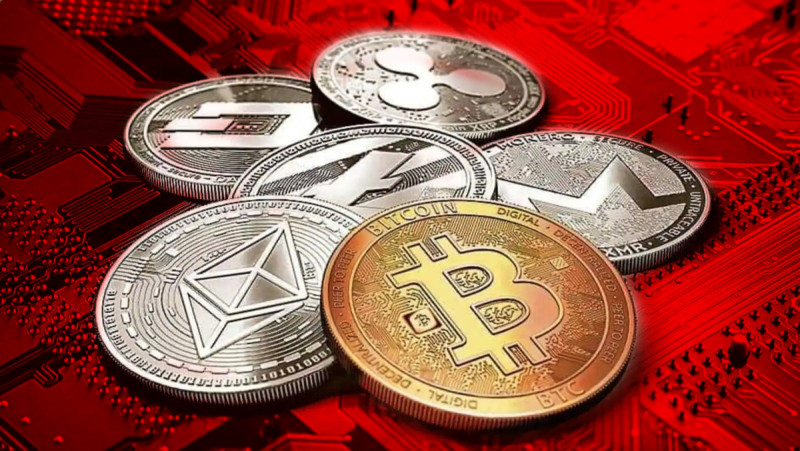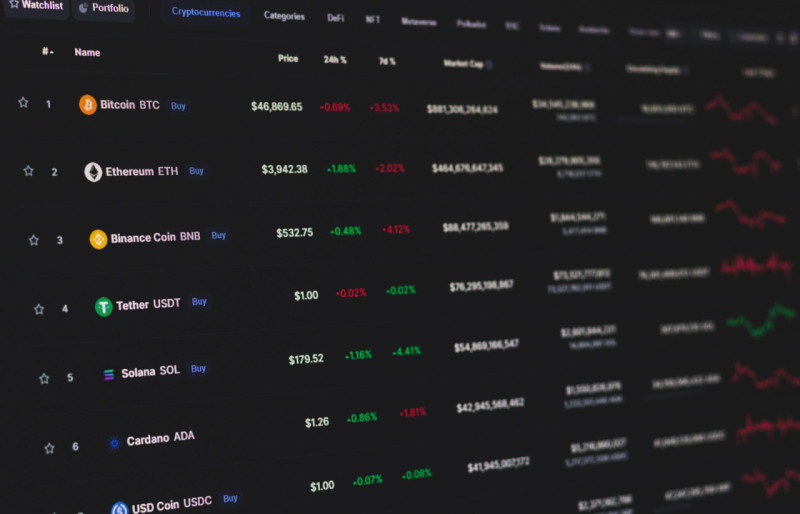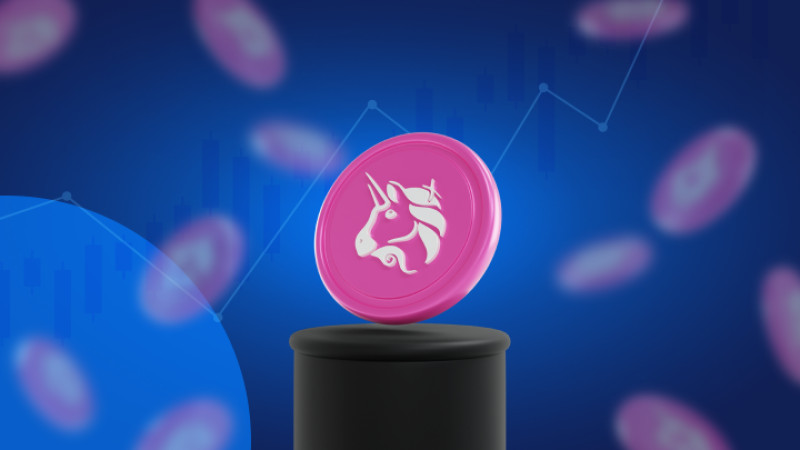
Cryptocurrency market
The cryptocurrency market operates much like the stock market, offering trading platforms for assets. While securities drive stock market investments, cryptocurrency projects revolve around tokens or coins.
One key characteristic of the cryptocurrency market is its high volatility. Token prices fluctuate based on various factors, with the most significant being mass adoption. The more holders a cryptocurrency has, the higher its value. This is why the most popular tokens often outperform others in price.
Such assets undergo appropriate listing on exchanges, allowing any user to purchase them. By buying a coin or token, the buyer automatically becomes an investor in the project. For more details, we recommend reading the article Basics of Cryptocurrency.
Many newcomers to the cryptocurrency world and those looking to earn in this field often wonder, "What is cryptocurrency listing?" This article explores the concept and how it can generate income.
What is cryptocurrency listing?
Cryptocurrency listing refers to the addition of a token or coin to an exchange. Once an asset is listed on a trading platform, it becomes available for purchase by anyone.
For a company, listing its token on an exchange is a crucial milestone for development. A successful listing can attract significant interest and numerous new buyers. This allows investors in the project to potentially earn profits at an early stage.
A strong asset performance can attract more investors, further driving up its price. If a project’s tokens achieve high value, the company may secure better credit terms for growth. Moreover, the company gains popularity, so potential clients will be more loyal.
Digital coins can be bought, sold, or simply stored on the exchange itself. Each coin carries a specific value.
How much does listing cost?
The exact cost of listing is unknown, as exchanges do not disclose this information. However, occasional leaks suggest an approximate range starting from $1 million to $3 million.
The listing cost varies depending on certain factors, for example, the project's demand. Listing more popular assets is typically more expensive than less popular ones. Thus, the higher the demand for a project, the higher the cost of its listing.
The exchange itself also plays a significant role. Despite a project's popularity, exchanges have independent pricing for listings. Some platforms offer better terms for promising projects, while others stick to fixed pricing for all.
The project’s uniqueness also impacts the listing cost. If a company creates a product with substantial technological potential, the exchange may find it valuable and offer a discounted listing rate. In summary, the listing cost heavily depends on the exchange’s interest in the project.
The popularity and reliability of the exchange also influence listing costs. For example, listing on platforms like Binance, Bybit, or BingX tends to be more expensive than on less popular exchanges. This is because popular exchanges garner more attention from news agencies and have a larger clientele, translating into more potential investors.
How does cryptocurrency listing work?

Now we understand what cryptocurrency listing is and its benefits for companies. Hence, let’s examine the process in detail.
To attract investors, exchanges often use ICO (Initial Coin Offering) and IEO (Initial Exchange Offering) methods. ICO allows anyone to purchase a token before its listing through the company’s website. However, this method alone may not guarantee success. To build trust and demand for the project, listing on an exchange is advisable.
If a company chooses to work directly with an exchange, it opts for IEO. This method shifts the responsibility for selling and promotion to the exchange. In turn, the exchange ensures convenience and security for the project.
To get listed on an exchange, a company must submit an application and provide details about the project. The exchange will then evaluate the project and its potential. If the decision is favorable, the exchange sets a date for the crowd sale. To participate, users must sign up for the exchange platform before the coin’s release. Over the next few days, the exchange integrates the asset into its marketplace, enabling users to trade it.
Once a coin appears on a cryptocurrency platform, it becomes usable. The more influential and popular the platform, the more users will trust the new project. However, this alone is not enough to significantly boost the asset’s value and profitability. Investors are essential to drive the project’s capitalization and growth.
Challenges in cryptocurrency listing
While many cryptocurrencies enjoy successful launches, there are numerous cases where new cryptocurrencies showed strong initial performance but were quickly forgotten. To achieve sustained growth, projects require continuous development, investment, and market engagement.
Stages of cryptocurrency listing
As we’ve already discussed, listing a token opens up many opportunities for a company. Let’s take a closer look at the steps involved in listing digital assets on an exchange.
Main stages:
- Submitting a listing application. Each exchange has its own rules and procedures for submitting an application.
- Providing product information. The company must disclose details about its project.
- Exchange evaluation. The exchange analyzes the project, assessing its quality and potential.
Experts conduct a thorough review, which can take anywhere from two days to several weeks. This involves examining the project’s technical aspects, compliance with regulations, and safety measures. They also evaluate the project’s liquidity and market appeal. The personal data of the project’s team members are also reviewed, with preference given to teams with significant experience and achievements in the blockchain industry.
Exchanges also consider whether the developers are prepared to promote and financially invest in the project further. The success of the project largely depends on this commitment. For this reason, major exchanges often avoid projects that lack active involvement from their creators.
If the evaluation yields positive results, the exchange provides a list of conditions for collaboration, which may include standard fees or specific percentages for certain events.
Before cooperation begins, a contract is signed, and a listing date is set. The company then actively promotes its project. On the scheduled date, the token is listed on the exchange, allowing users to trade it.
ICO and IEO
Cryptocurrency listing is closely related to two other concepts: ICO and IEO. These acronyms stand for Initial Coin Offering and Initial Exchange Offering, respectively.
An ICO is essentially a fundraising event during which a developer sells their tokens. In return, the company may receive fiat money or another, more popular cryptocurrency. The goals of an ICO can vary but are often linked to:
- Raising funds for the project;
- Building and uniting a community interested in cryptocurrency;
- Conducting a marketing campaign.
However, ICOs carry risks. Investors might remain in limbo for a long time while waiting for profits, or the startup might close before even listing its tokens.
This is why IEOs have gained popularity. IEOs, or Initial Exchange Offerings, are similar to ICOs but are conducted with the support of a functioning exchange. The exchange oversees the sale and promotion of the token, providing greater reliability and security for both the project and investors.
Where to track cryptocurrency listings?
Here are some sources that can help you stay updated on new cryptocurrency listings:
- Social media accounts of exchanges. Follow the exchanges you’re interested in for updates on crypto projects and innovations.
- Crypto-related websites. Look for sites that publish upcoming and significant cryptocurrency events.
- Telegram bots. Subscribe to bots that send notifications about cryptocurrency news and listings.
What influences project's approval for listing?

For a project to be listed, it must meet certain criteria. Let’s explore the factors that increase the chances of a project being listed on an exchange:
- Clear business structure and value proposition. Projects with unique innovations or significant contributions to the cryptocurrency industry are more likely to be prioritized. Exchanges favor projects that demonstrate practical applications and benefits for technology.
- Active community. A project with a large and engaged user base is more appealing. Supportive users who promote the project and attract others significantly impact its listing potential.
- Team reputation. The exchange evaluates the team’s credibility and track record. Teams with substantial experience and successful past projects are given priority.
- Project security. Developers must ensure the security of their project. A robust blockchain structure that prevents hacking attempts is crucial.
Listing process
Listing a cryptocurrency on an exchange involves several of the factors mentioned above. Exchanges meticulously review each project to ensure it meets their standards and assess its growth potential. If the exchange approves the listing, the project can rely on the platform to provide favorable conditions and promote it effectively.
By meeting these criteria, companies increase their chances of listing success, paving the way for better visibility, trust, and growth opportunities in the cryptocurrency market.
Delisting
Sometimes, projects are removed from exchanges in a process called "delisting". When this happens, it often damages the project’s reputation.
Reasons for delisting:
- Insufficient trading volume. Exchanges usually support projects that attract user interest. The assets must be in demand and frequently traded, as the exchange earns revenue from transactions. Moreover, low-demand assets are often targeted by fraudsters in their schemes. By delisting such projects, exchanges maintain security for their users.
- Low market capitalization. Projects that fail to achieve significant capitalization are at risk of delisting, especially newer ones that fail to gain traction. Similarly, assets may be removed if they lose popularity and users stop investing in them actively.
- Violation of exchange rules. Projects must meet specific standards and rules for listing. If these are violated during their time on the exchange, the project may face delisting.
- Technical issues. If an asset faces technical malfunctions, exchanges may perceive it as vulnerable and unsafe for users. For instance, if the asset risks being hacked and developers fail to resolve the issue, the exchange may opt to delist it.
- Negative user feedback. If an exchange receives numerous complaints, it may remove the asset to protect its own reputation.
When issues arise, the exchange typically informs the project’s creators. If the problems are resolved, the project remains on the platform. Otherwise, a delisting date is set.
What happens before delisting?
Before delisting, users receive recommendations, such as how and when to sell the asset. Typically, users are given a week to withdraw their funds. After this period, the project is fully removed from the exchange, and any unclaimed funds are lost.
How to earn from listing
Both project teams and regular traders can profit from cryptocurrency listings.
Before an asset is listed on an exchange, creators often store a portion of it in a special fund. These funds are used for the product’s technical development and to pay developers. The coin’s value directly affects how much creators can access. By selling some of the stored assets, they can generate significant profits without drastically affecting the token’s price.
For traders, cryptocurrency listings also present lucrative opportunities. The best time to buy an asset is right after its listing—or even earlier—when prices are lower.
Examples of successful listings:
In 2020, Aave launched at $9.7 per coin on its listing day. A week later, its price rose to $26.
In 2019, DF experienced a price surge from $0.11 to $0.33 within 24 hours of its listing.
In 2020, The Graph debuted at $0.03 per token and reached $0.783 within a few days.
However, not all listings result in immediate price growth. Sometimes, prices drop as investors sell off large quantities of the newly listed asset.
Examples of price drops after listing:
Hegic's price fell from $0.2811 to $0.2 within 24 hours of listing.
Rose experienced a sharp price decline within hours of its listing, dropping several times its initial value.
How to acquire cryptocurrency
Airdrops
Some projects distribute tokens for free. The idea is simple—the more users a product has, the more valuable it becomes. To participate, users may need to complete tasks such as trading tokens or engaging on social media.
Helping others
Certain platforms reward users with tokens for assisting others. For example, users can ask questions and receive tokens for providing helpful answers. These platforms are often available in multiple languages for accessibility.
Affiliate marketing
Bloggers, news sites, and individual users can earn cryptocurrency through affiliate programs. Companies provide a personal URL link to share, and users earn rewards or bonuses for every purchase made via the link.
Playing games

Some games allow users to earn tokens, which can be converted into real currency. Examples include:
Bitcoin Alien Run: Available on Android and iOS, this game offers both entertainment and earnings.
Spark Profit: A trading simulator where players predict price movements to learn and earn.
Spells of Genesis: A game that integrates blockchain with in-game assets.
Flexible deposits
Users lend their digital assets to projects and earn tokens in return. This method ensures stable earnings regardless of market conditions and functions similarly to a savings account for cryptocurrency.
Criteria for choosing cryptocurrency
To maximize profit, it’s essential to thoroughly analyze the asset. Here are key criteria to consider:
- Large market capitalization (over $1 billion). Indicates trust from major investors and the project’s popularity.
- Purpose and demand. Evaluate the project’s use case, such as smart contracts, fast transactions, or decentralized apps (dApps). The more significant the problem it solves, the better.
- Integration with existing businesses. Projects linked to exchanges or popular services often have higher token demand.
- Experienced developers. Teams with a history of successful projects and regular updates inspire confidence.
- Activity on GitHub. Frequent updates show that developers are actively improving the project.
- Strong recent performance. Consistent growth in price and market capitalization over the past six months is a good sign.
- Secure and reliable blockchain. Ensure the blockchain is resistant to hacking and system failures.
Considering these factors can reduce risks and improve investment outcomes.
Conclusion
Cryptocurrency listings can be highly profitable in the digital asset market. While most listed projects show strong growth, there are exceptions.
To increase the chances of successful investments, stay informed about emerging startups, track their development plans, monitor industry forums, and follow official exchange pages. Combining these efforts will help maximize returns on your investments.








 Back to articles
Back to articles



